News
Faculty of Art and Design Provost Receives a Commendation from Mifune Town Mayor for Restoring Paintings Damaged by the Kumamoto Earthquakes
Students and staff in the Hozon Kagaku Kenkyushitsu (Preventive Conservation Laboratory) led by Professor Toshiya Matsui of the Faculty of Art and Design have been involved in the restoration of paintings damaged by the Kumamoto Earthquakes that occurred on April 14, 2016. The paintings were originally painted by the late Mr. Keiichi Tanaka, an artist who lived in Mifune Town in Kumamoto Prefecture. They had been stored in his atelier when the earthquakes occurred. After the disaster, Mifune Town made a request to the University of Tsukuba to repair the damaged paintings. Since then, the laboratory members have been engaged in repairing the paintings with guidance from a specialist in the field of painting restoration.
Although some paintings are badly damaged and are still in need of repair, almost all the paintings were repaired and returned to Mifune Town. Showing gratitude to the university, Mifune Town Mayor Fujiki presented a letter of commendation to Provost Yamanaka of the Faculty of Art and Design on February 19 (Mon), 2018.
Combining its knowledge and skills as a comprehensive university that teaches art, and making use of its experience, the University of Tsukuba intends to continue efforts to support the arts, including the repair of artworks that are damaged by disasters.
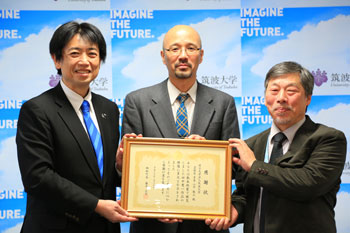
From left: Mifune Town Mayor Fujiki, Professor Matsui of the Faculty of Art and Design, Provost Yamanaka of the Faculty of Art and Design
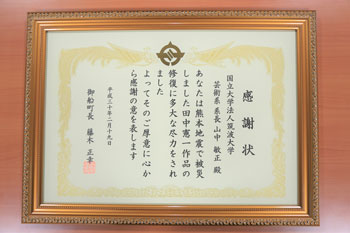
Letter of Commendation from the Mayor of Mifune Town
Comment from Mifune Town Mayor Masayuki Fujiki
I would like to express my gratitude to the University of Tsukuba for repairing Keiichi Tanaka' paintings that had been damaged by the Kumamoto Earthquakes. Thanks to many people's efforts, including Professor Matsui and students in his laboratory, we could save the lives of Tanaka's paintings. As a Mifune Town Mayor, I have a duty to hand down Tanaka's paintings to posterity. I will always be grateful for their help and take good care of the paintings.Background
Paintings by the late Mr. Keiichi Tanaka had been trapped under debris after the Kumamoto Earthquakes occurred on April 14, 2016. The paintings included 70 large-sized paintings (oil paintings) and 30 small paintings. After a while, they were retrieved from the rubble of the collapsed building, and stored in a building of Mifune Town. In addition to the collapse damage, the paintings got moldy and their coloration (saishiki) and base (shijiso) got weakened, because they had been exposed to rain and mud in the collapsed building. Under these circumstances, art officials from Kumamoto Prefecture found that the Hozon Kagaku Kenkyushitsu (Preventive Conservation Laboratory) of the University of Tsukuba has the experience of giving stabilization and first-aid treatment to damaged art works in a museum in disaster-affected area after the Great East Japan Earthquakes, and asked them for support.The laboratory's art rescue activities in Mifune Town
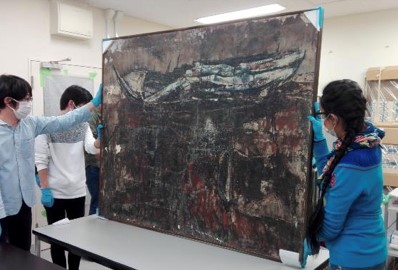
One of Keiichi Tanaka' paintings damaged by the Kumamoto earthquake
When the laboratory members checked the paintings' condition, they found black mold grew on multiple paintings. They decided to take a fumigation process in Mifune Town, where the paintings were kept in, to prevent them from deteriorating and reduce the health risks of the team members. After checkig the condition, the paintings were close-packed with deoxidant and high gas barrier films. This close-packing procedure enabled a low-oxygen environment for the paintings and prevented mold and insects from growing on them for several years. It was carried out for the reason that: the laboratory didn't have an outlook on when they can secure a site suitable for the paintings' storage; there was concern about the recurrence of mold after the fumigation process; and the repair work was determined to take at least a year.
A total of 48 paintings that are in urgent need of first-aid treatment and repair procedures were sent to the University of Tsukuba in October, 2016.
* "Tanaka Keiichi Sakuhin wo Sukuu Kai (Aassociation to help Keiichi Tanaka's paintings)" in Mifune Town decided to collect funds needed for repairing Tanaka's paintings through crowd-funding. (They collected 616,000 yen in total.) The funds were used for the art rescue activities.
Repair work at the University of Tsukuba
The following procedures were implemented by the laboratory members: removal of mud and dust, omoteuchi procedure (process to protect the surface of the painting) using Japanese paper, and a procedure of hakurakudome (process to prevent the colors coming off). After these steps, the paintings were close-packed in high gas barrier films filled with nitrogen gas. The paintings will be stored in this condition until the next repair procedures.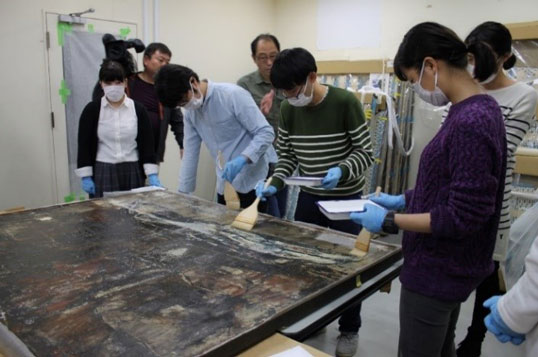
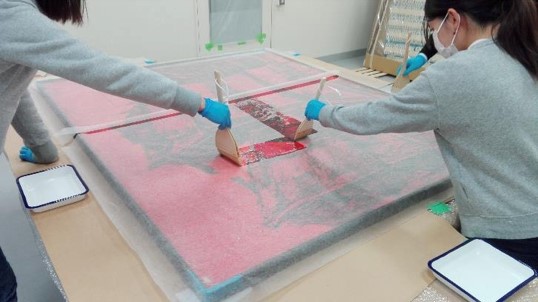
Omoteuchi (process to protect the surface of the painting)
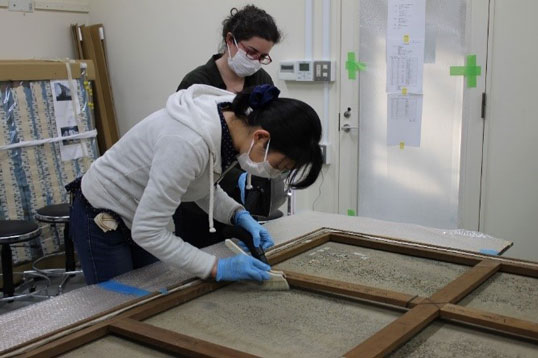
Process to remove grit and dust from the back side of the painting
Through the repair works
Many universities are expected to become a base of support activities for people affected by disaster. With the experience in Mifune Town, we had a chance to reconsider what we can do and we cannot do as a university in case of a disaster, and we did what we could do. For students, they had an opportunity to experience putting their knowledge and skills into practice and adapting to circumstances. In addition to the importance of technique and skills, they could learn the importance of building a trusted relationship and raising needed capital, by working with many people including supervisors, owners, and local residentsThe laboratory's past achievements
The laboratory has worked for museums affected by the Great East Japan Earthquakes. It gave emergency treatment for stored archives, historical documents, ancient documents, and hanging scrolls. It also has an experience of cooperating with a museum's reconstruction plan. It is currently working in Yamada Town in Iwate Prefecture, and Ichinomaki City in Miyagi Prefecture.【Ibaraki Prefecture】Kashima City, Yuki City, Toride City, Hitachiota City, Hitachiomiya City, Mito City, Ibaraki Prefectural Museums
【Miyagi Prefecture】Ishinomaki City, Miyagi Prefectural Museums
【Iwate Prefecture】Otsuchi Town, Yamada Town, etc.
Hozon Kagaku Kenkyushitsu (Preventive Conservation Laboratory)
The laboratory conducts research in the field of preventive conservation, which aims to prevent deterioration of historical remains and cultural assets, and the research on restoration material and techniques.The laboratory members are currently involved in: repairs of carvings on the Angkor monuments in Cambodia; preservation works of Meiji era bricks; and research on the conservation environment of the museums.
Inquiries
Professor Toshiya MatsuiFaculty of Art and Design, University of Tsukuba
Related Link
Hozon Kagaku Kenkyushitsu (Preventive Conservation Laboratory)(Japanese page)


